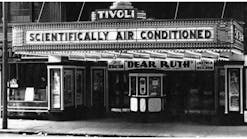During an early planning meeting for a new large automobile-assembly plant that was to be built in the southwestern part of the United States, the planning committee was informed that the plant would be air-conditioned via mechanical refrigeration. The committee also was informed that, with a new paint process, relative humidity (RH) in production booths would need to be maintained below 45 percent at all times.
It was estimated that roughly 2,000 tons of refrigeration would be required to air-condition the plant. In addition, several hundred tons of refrigeration were estimated to be required to control the RH of the air flowing through the production booths.
Having recently been involved in an operation in which RH was not important as long as it was kept at a steady level, I was aware of the changes of RH in air as dry-bulb (DB) temperature changed. For example, if the DB temperature of air at 7 a.m. is 70°F, and the RH is 95 percent, when the DB temperature is 95°F in the afternoon, the RH will be about 45 percent.
I suggested that the company have a consulting meteorologist conduct a study to see if the building refrigeration could handle both loads. It was my belief that there never would be a time when the refrigeration systems for the plant and the production booths would require the maximum refrigeration capacity at the same time.
The company acted on my suggestion and hired a consulting meteorologist to carry out the recommended study, using recorded wet- and dry-bulb temperatures in the area where the plant was to be built. The study showed what I expected: The maximum refrigeration load on the main building and the production operation never occurred at the same time. According to the study, the building refrigeration system could handle both requirements if controlled properly. This would greatly reduce installation and operating costs, while providing comfort cooling and control of the RH required for production.
It pays to study carefully all system requirements using local weather recordings and not to design simply with generalizations.
Kenneth E. Robinson, CIH
Mears, Mich.
Have a “war story” to share? Send it to Executive Editor Scott Arnold at [email protected]. Authors are paid $50 per published war story.








